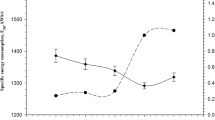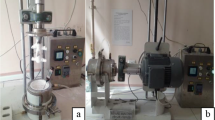Abstract
This manuscript aimed to examine the impact of operating parameters on the wet grinding of talc in a vertical-type stirred media mill. Within the scope of the research, the effects of operating parameters including media filling ratio, solid mass fraction, grinding media size, and grinding time were studied. The findings were assessed based on the product particle size (d50, d10), surface area (Sw), and energy consumption (Em). As a result of the present research, the following optimum grinding test conditions were determined: 65% media filling ratio, 40% solid mass fraction, 1 mm grinding media size, and 120 min grinding time. After determining the optimum grinding conditions, the Box–Behnken statistical design was used to determine the effect of parameter interactions on the d50 size. The media filling ratio was found to significantly affect the decrease in d50 compared to the other two parameters. Furthermore, the minimum d50 size was also achieved under optimum grinding conditions.










Similar content being viewed by others
References
Sanchez-Soto PJ, Wiewiora A, Aviles MA, Justo A, PerezMaqueda LA, Perez-Rodriguez JL, Bylina (1997) Talc from Puebla de Lillo, Spain: II. Effect of dry grinding on particle size and shape. Appl Clay Sci 12:297–312. https://doi.org/10.1016/S0169-1317(97)00013-6
Katz HS, Milewski JW (1987) Handbook of fillers for plastics. Van Nostrand Reinhold, New York
Likitalo M (2000) Talc. In pigment coating and surface sizing of paper, chapter 7, 107–119. In: Lehtinen E, Oy F (eds). Finnish Paper Engineers’ Association and TAPPI, Helsinki
Bizi M, Flament MP, Baudet G, Gayot A (2003) Relation between structural characteristics of talc and its properties as an antisticking agent in the production of tablets. European Journal Pharm Sci 19:373–379. https://doi.org/10.1016/S0928-0987(03)0013
Martin PJ, Wilson DI, Bonnett PE (2004) Rheological study of a talc-based paste for extrusion-granulation. J Eur Ceram Soc 24:3155–3168. https://doi.org/10.1016/j.jeurceramsoc.2003.11.003
Terada K, Yonemochi E (2004) Physicochemical properties and surface free energy of ground talc. Solid State Ionics 172:459–462. https://doi.org/10.1016/j.ssi.2004.03.032
Goren R, Gocmez H, Ozgur C (2006) Synthesis of cordierite powder from talc, diatomite and alumina. Ceram Int 32:407–409. https://doi.org/10.1016/j.ceramint.2005.03
Neto JBR, Moreno R (2007) Rheological behavior of kaolin/talc/ alumina suspensions for manufacturing cordierite foams. Appl Clay Sci 3:157–166. https://doi.org/10.1016/j.clay.2006.12.007
Grafia AL, Castillo LA, Barbosa SE (2014) Use of talc as low-cost clarifier for wastewater. Water Sci Technol 69(3):640–646. https://doi.org/10.2166/wst.2013.755
Ossman ME, Mansour MS, Fattah MA, Taha N, Kiros Y (2014) Peanut shells and talc powder for removal of hexavalent chromium from aqueous solutions. Bul Chem Commun 3(3):629–639
Sani HA, Ahmad MB, Saleh TA (2016) Synthesis of zinc oxide/talc nanocomposite for enhanced lead adsorption from aqueous solutions. RSC Adv 6(110):108819–108827. https://doi.org/10.1039/C6RA24615J
Balamurugan GP, Maiti SN (2010) Effects of nanotalc inclusion on mechanical, microstructural, melt shear rheological, and crystallization behavior of polyamide 6- based binary and ternary nanocomposites. Polym Eng Sci 50:1978–1993. https://doi.org/10.1002/pen.21724
Sakthivel S, Pitchumani B (2011) Production of nano talc material and its applicability as filler in polyeric nanocomposites. Part Sci Tech 29:441–449. https://doi.org/10.1080/02726351.2010.510166
Lee D, Kim S, Kim B, Chun S, Lee S, Wu Q (2017) Effect of nano-CaCO3 and Talc on property and weathering performance of PP composites. Int J Polym Sci 2017, Article ID 4512378. https://doi.org/10.1155/2017/4512378
Leong YW, Abu Bakar MB, Mohd Ishak ZA, Ariffin A (2004) Characterization of talc/calcium carbonate filled polypropylene hybrid composites weathered in a natural environment. Polym Degrad Stab 83(3):411–422. https://doi.org/10.1016/j.polymdegradstab.2003.08.004
Clerc L, Ferry L, Leroy E, Lopez-Cuesta JM (2005) Influence of talc physical properties on the fire retarding behaviour of (ethylene–vinyl acetate copolymer/magnesium hydrox-ide/talc)composites. Polym Degrad Stab 88:504–511. https://doi.org/10.1016/j.polymdegradstab.2004.12.010
Dzulkafli HH, Ahmada F, Ullahb S, Hussaina P, Mamat O, Megat-Yusoff PSM (2017) Effects of talc on fire retarding, thermal degradation and water resistance of intumescent coating. Appl Clay Sci 146:350–361. https://doi.org/10.1016/j.clay.2017.06.013
Akhtar S, Shukla D, Kumar V (2008) Studies on effect of nano-talc filer on nucleation, crystal morphology and crystallization behaviour of semi-crystalline plastics. Solid State Phenom 136:161–174. https://doi.org/10.4028/www.scientific.net/SSP.136.161
Godet-Morand L, Chamayou A, Dodds J (2002) Talc grinding in an opposed air jet mill: start-up, product quality and production rate optimization. Powder Technol 128:306–313. https://doi.org/10.1016/S0032-5910(02)00172-9
Aglietti EF (1994) The effect of dry grinding on the structure of talc. Appl Clay Sci 9:139–147. https://doi.org/10.1016/0169-1317(94)90033-7
Filio JM, Sugiyama K, Saito F, Waseda Y (1991) A study of changes of structure and physical properties of talc ground by tumbling and planetary ball mills. Int. Conf. on Materials Engineering for Resources, ICMR'91, Akita, Japan, 6–7
Zbik M, Smart RSC (2005) Influence of dry grinding on talc and kaolinite morphology: inhibition of nano-bubble formation and improved dispersion. Miner Eng 18:969–976. https://doi.org/10.1016/j.mineng.2005.01.005
Dellisanti F, Valdrè G, Mondonico M (2009) Changes of the main physical and technological properties of talc due to mechanical strain. Appl Clay Sci 42:398–404
Kano J, Saito F (1998) Correlation of powder characteristics of talc during planetary ball milling with the impact energy of the balls simulated by the particle element method. Powder Technol 98:166–170. https://doi.org/10.1016/S0032-5910(98)00039-4
Sakthivel S, Venkatesh RP (2012) Solid state synthesis of nano-mineral particles. Int J Min Sci Technol 22:651–655 https://doi.org/10.1016/j.ijmst.2012.08.010
Ohenoja K, Illikainen M (2015) Effect of operational parameters and stress energies on stirred media milling of talc. Powder Technol 283:254–259. https://doi.org/10.1016/j.powtec.2015.05.036
Knieke C, Sommer M, Peukert W (2009) Identifying the apparent and true grinding limit. Powder Technol 195:25–30. https://doi.org/10.1016/j.powtec.2009.05.007
Breitung-Faes S, Kwade A (2013) Prediction of energy effective grinding conditions. Miner Eng 43–44:36–43. https://doi.org/10.1016/j.mineng.2012.07.015
Bel Fadhel H, Frances C (2001) Wet batch grinding of alumina in a stirred bead mill. Powder Technol 119:257–268 https://doi.org/10.1016/S0032-5910(01)00266-2
Jayasundara CT, Yang RY, Yu AB, Rubenstein J (2010) Effects of disc rotation speed and media loading on particle flow and grinding performance in a horizontal stirred mill. Int J Miner Process 96:27–35. https://doi.org/10.1016/j.minpro.2010.07.006
Jayasundara CT, Yang RY, Yu AB (2012) Effect of the size of media on grinding performance in stirred mills. Miner Eng 33:66–71 https://doi.org/10.1016/j.mineng.2011.10.012
Jankovic A (2003) Variables affecting the fine grinding of minerals using stirred mills. Miner Eng 16(4):337–345 https://doi.org/10.1016/S0892-6875(03)00007-4
Celep O, Aslan N, Alp I, Tasdemir G (2011) Optimization of some parameters of stirred mill for ultra-fine grinding of refractory au/ag ores. Powder Technol 208:121–127. https://doi.org/10.1016/j.powtec.2010.12.009
Radziszewski P (2013) Assessing the stirred mill design space. Miner Eng 41:9–16 https://doi.org/10.1016/j.mineng.2012.10.012
Bernhart C, Reinsdh E, Husemann K (1999) The influence of suspension properties on ultra-fine grinding in stirred ball mills. Powder Technol 105:357–361 https://doi.org/10.1016/S0032-5910(99)00159-X
Choi WS (1996) Grinding rate improvement using a composite grinding ball size for an ultra-fine grinding mill. Journal of the Society of Powder Technol 33:747–752. https://doi.org/10.4164/sptj.33.747
Shinohara K, Golman B, Uchiyama T, Otani M (1999) Fine-grinding characteristic of hard material by attrition mill. Powder Technol 103:292–296. https://doi.org/10.1016/S0032-5910(99)00042-X
Choi H, Wang L (2007) A quantitative study of grinding characteristics on particle size and grinding consumption energy by stirred ball mill. Korean J Mater Res 17(10):532–537
Choi H, Lee W, Lee J, Chung H, Choi W (2007) Ultra-fine grinding of inorganic powders by stirred ball mill: effect of process parameters on the particle size distribution of ground products and grinding energy efficiency. Met Mater Int 13:353–358. https://doi.org/10.1007/BF03027893
Shi F, Morrison R, Cervellin A, Burns F, Musa F (2009) Comparison of energy efficiency between ball mills and stirred mills in coarse grinding. Miner Eng 22:673–680. https://doi.org/10.1016/j.mineng.2008.12.002
Mankosa MJ, Adel GT, Yoon RH (1986) Effect of media size in stirred ball mill grinding of coal. Powder Technol 49:75–82. https://doi.org/10.1016/0032-5910(86)85008-2
Katircioglu-Bayel D, Ozkan SG, Toraman OY (2019) Effect of operating parameters on the breakage process of calcite in a stirred media mill. Mining, Metallurgy & Exploration 36(2):399–408. https://doi.org/10.1007/s42461-018-0008-8
Austin LG, Klimpel RR, Luckie PT (1984) Process engineering of size reduction: ball milling. SME, New York 561 pp
Zhang YM, Napier-Munn TJ (1995) Effects of particle size distributions surface area and chemical composition on Portland cement strength. Powder Technol 83:245–52. https://doi.org/10.1016/0032-5910(94)02964-P
Hasegawa M, Kimata M, Shimane M, Shoji M, Tsuruta M (2001) The effect of liquid additives on dry ultrafine grinding of quartz. Powder Technol 114:145–151. https://doi.org/10.1016/S0032-5910(00)00290-4
Garcia F, Le Bolay N, Trompette J, Frances C (2004) On the fragmentation and phenomena in an ultrafine wet grinding process: The role of polyelectrolyte additives. Int J Miner Process 74:43–54. https://doi.org/10.1016/j.minpro.2004.07.001
Kwade A, Schwedes J (2007) Wet grinding in stirred media mills. Handbook of Powder Technol 12:251–382. https://doi.org/10.1016/S0167-3785(07)12009-1
Ohenoja K, Illikainen M, Niinimäki J (2013) Effect of operational parameters and stress energies on the particle size distribution of TiO2 pigment in stirred media milling. Powder Technol 234:91–96. http://dx.doi.org/10.1016/j.powtec.2012.09.038
Kwade A, Blecher L, Schwedes J (1996) Motion and stress intensity of grinding beads in stirred media mill. Part 2: Stress intensity and its effect on comminution. Powder Technol 86:69–76. https://doi.org/10.1016/0032-5910(95)03038-7
Bond FC (1958) Grinding ball size selection. Trans. AIME, 592–595
Wang Y, Forssberg E (2000) Product size distribution in stirred media mills. Miner Eng 13:459–465. https://doi.org/10.1016/S0892-6875(00)00025-X
Mende S, Stenger F, Peukert W, Schwedes J (2004) Production of sub micron particles by wet comminution in stirred media mills. J Mater Sci 39:5223–5226. https://doi.org/10.1023/B:JMSC.0000039214.12131.58
Montgomery DC (2001) Design and analysis of experiments (New York: John Wiley and Sons)
Acknowledgments
The author would like to express her gratitude to Mikron's Company for providing specimens for the current research.
Author information
Authors and Affiliations
Corresponding author
Ethics declarations
Conflict of Interest
The author declares no conflict of interest in terms of the publication of the present article.
Additional information
Publisher’s Note
Springer Nature remains neutral with regard to jurisdictional claims in published maps and institutional affiliations.
Rights and permissions
About this article
Cite this article
Katircioglu-Bayel, D. Impact of Operating Parameters on the Breakage Process of Talc. Mining, Metallurgy & Exploration 37, 1717–1727 (2020). https://doi.org/10.1007/s42461-020-00270-1
Received:
Accepted:
Published:
Issue Date:
DOI: https://doi.org/10.1007/s42461-020-00270-1




